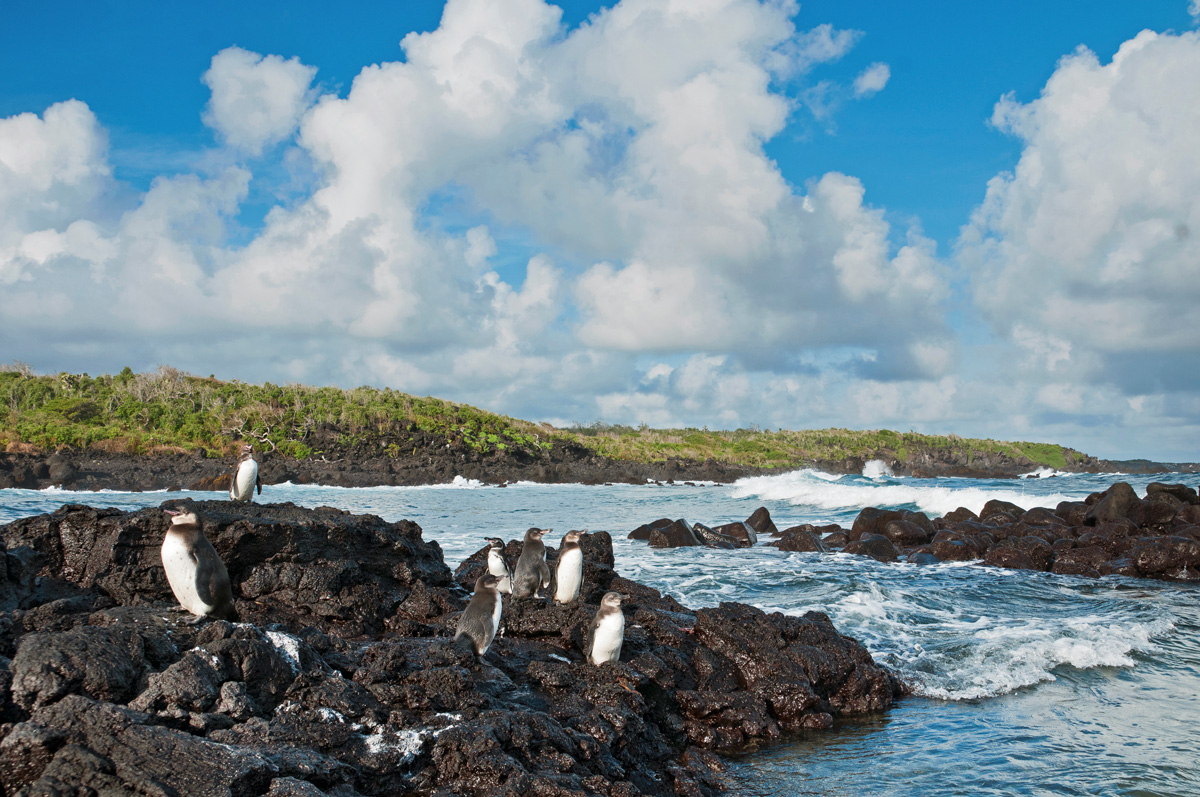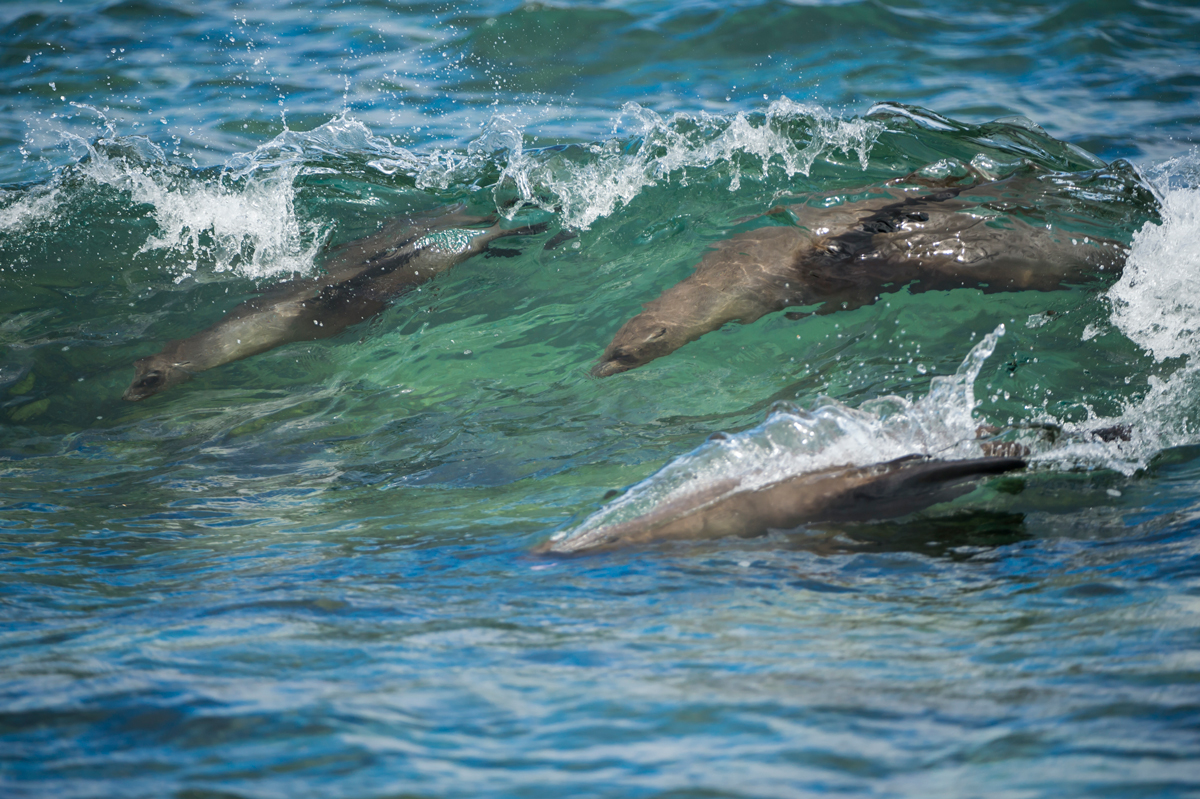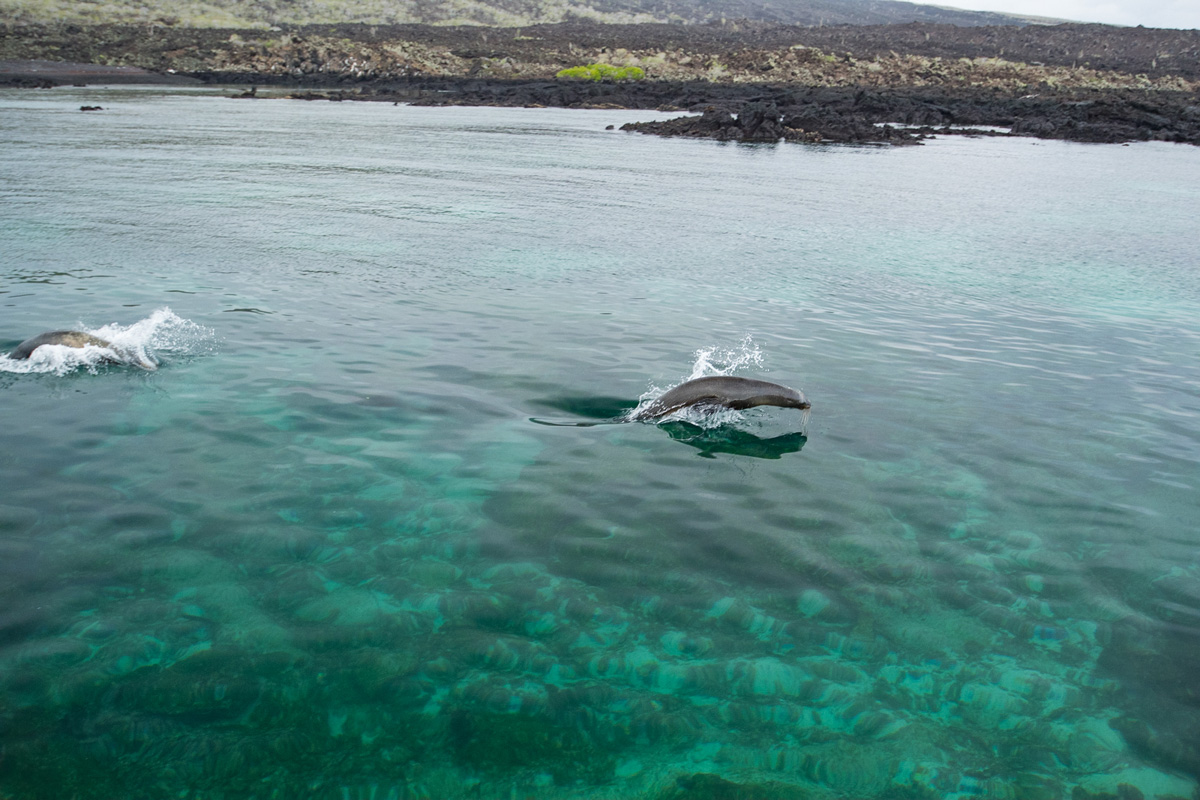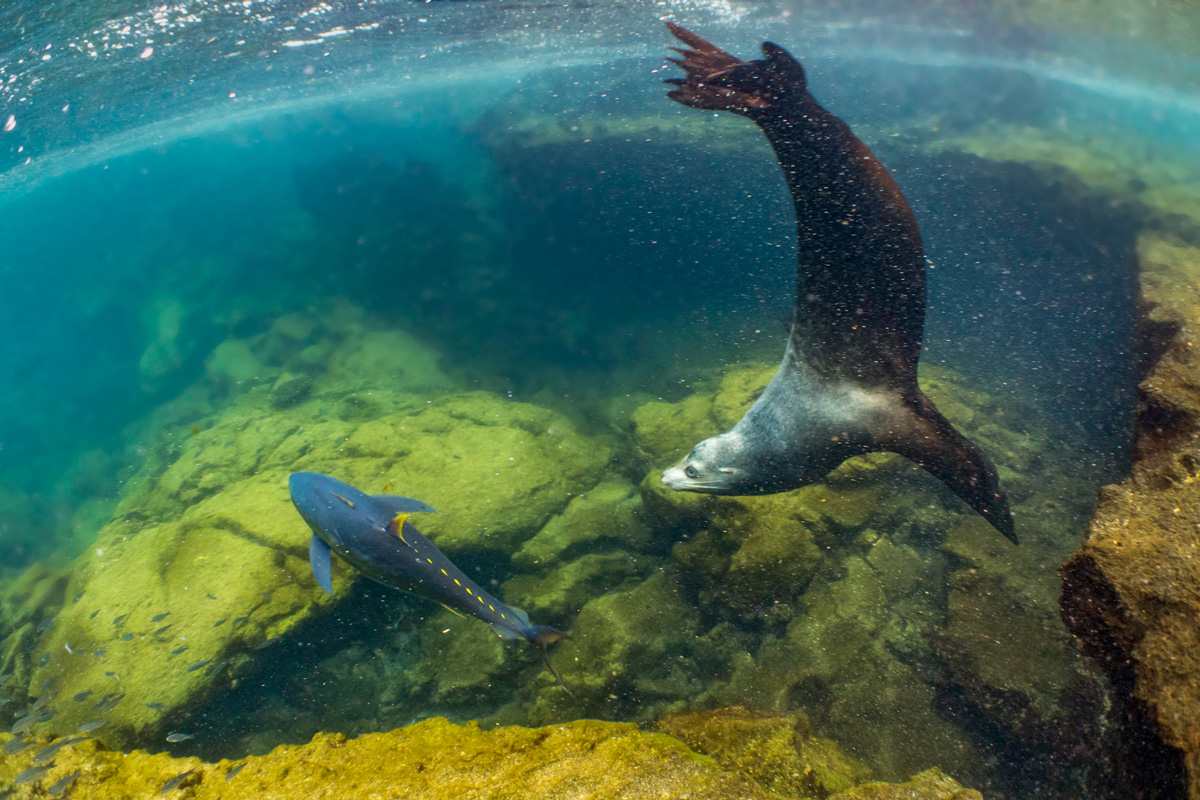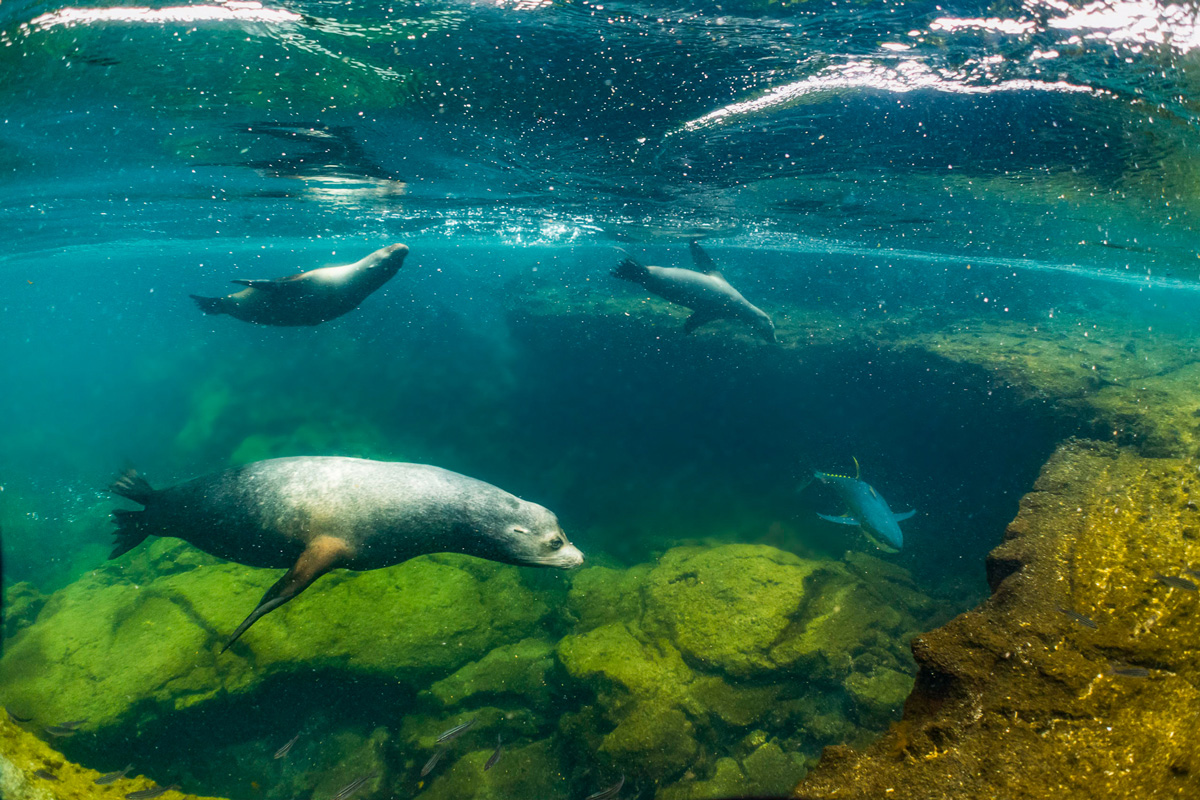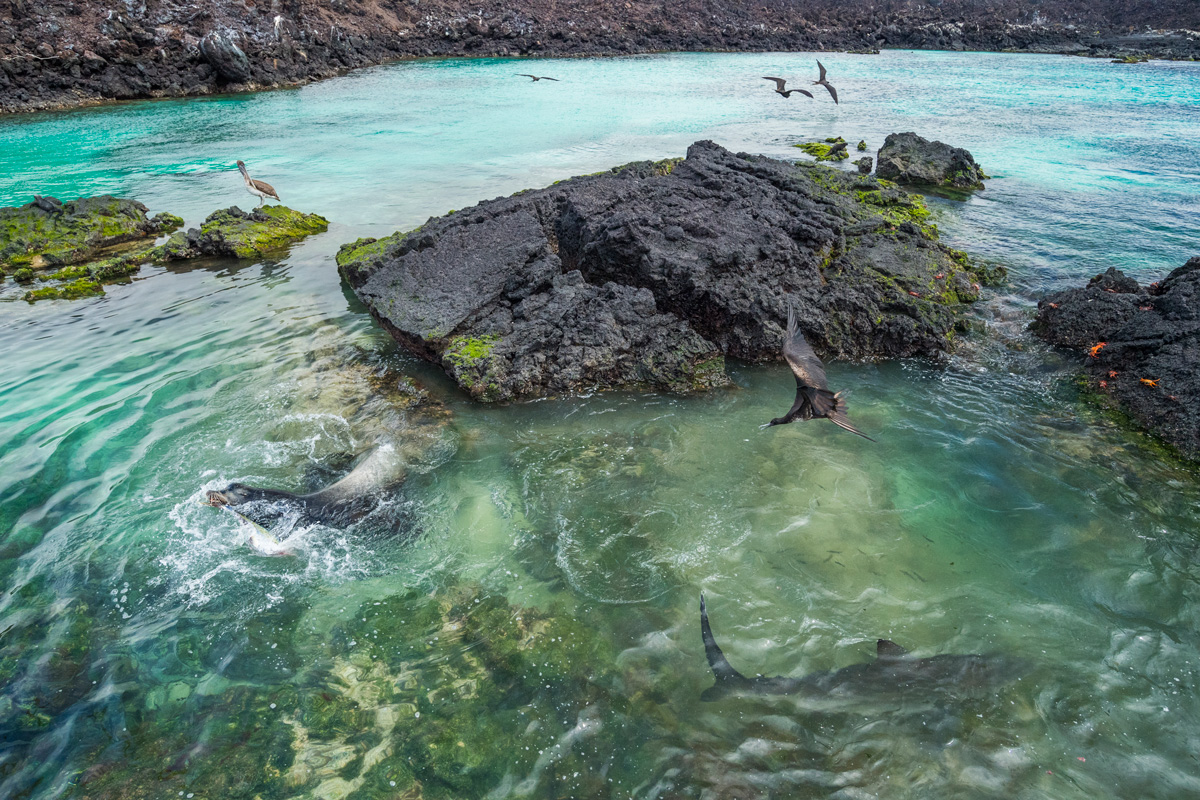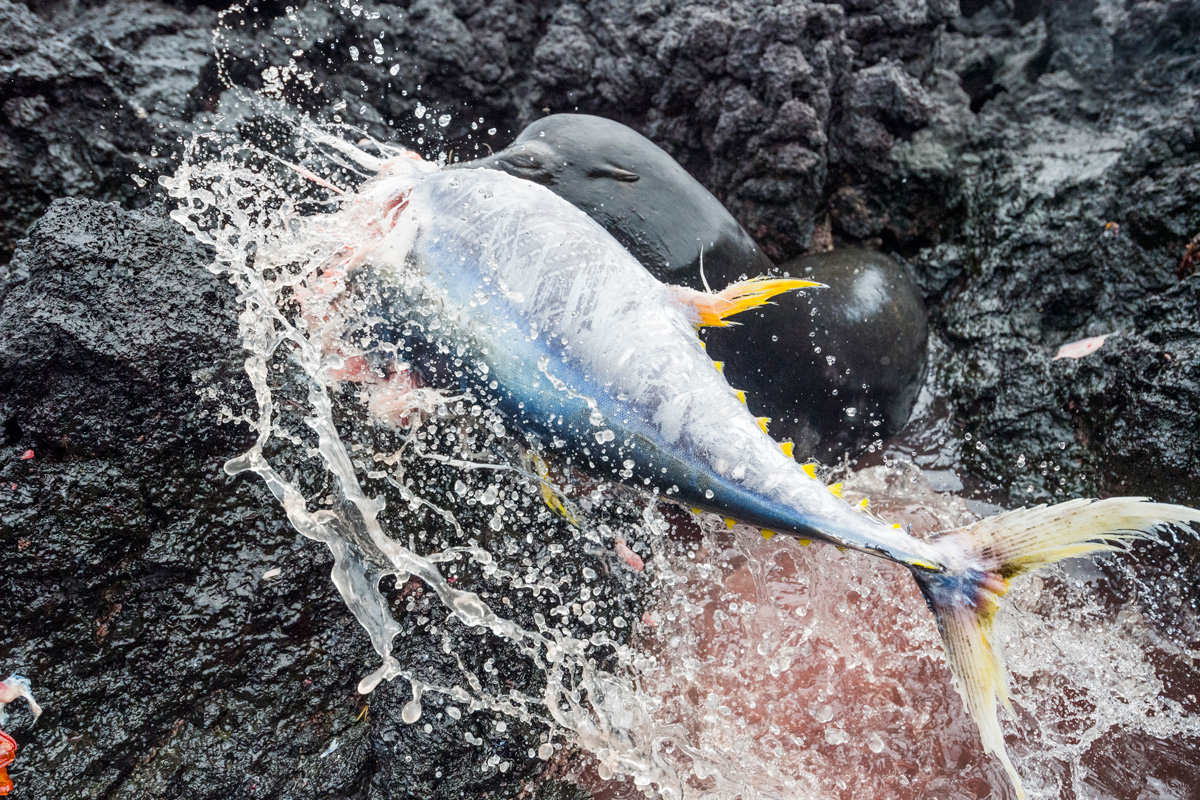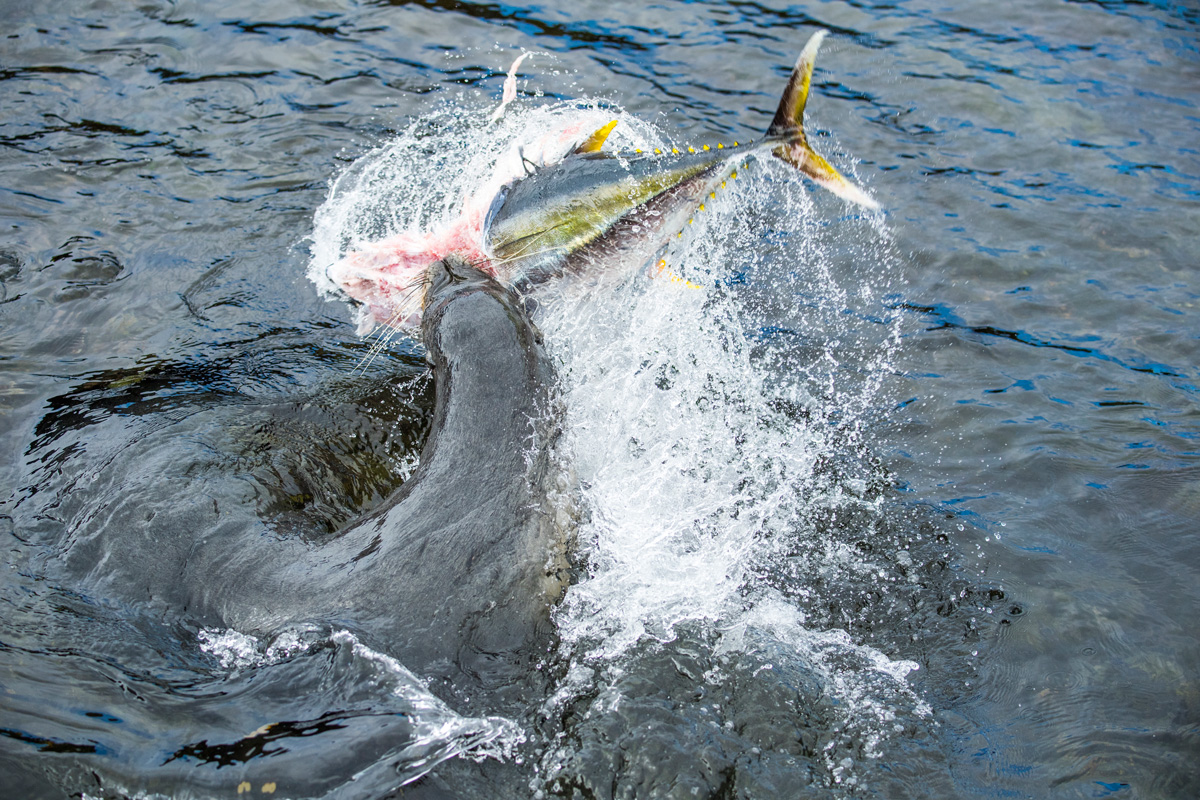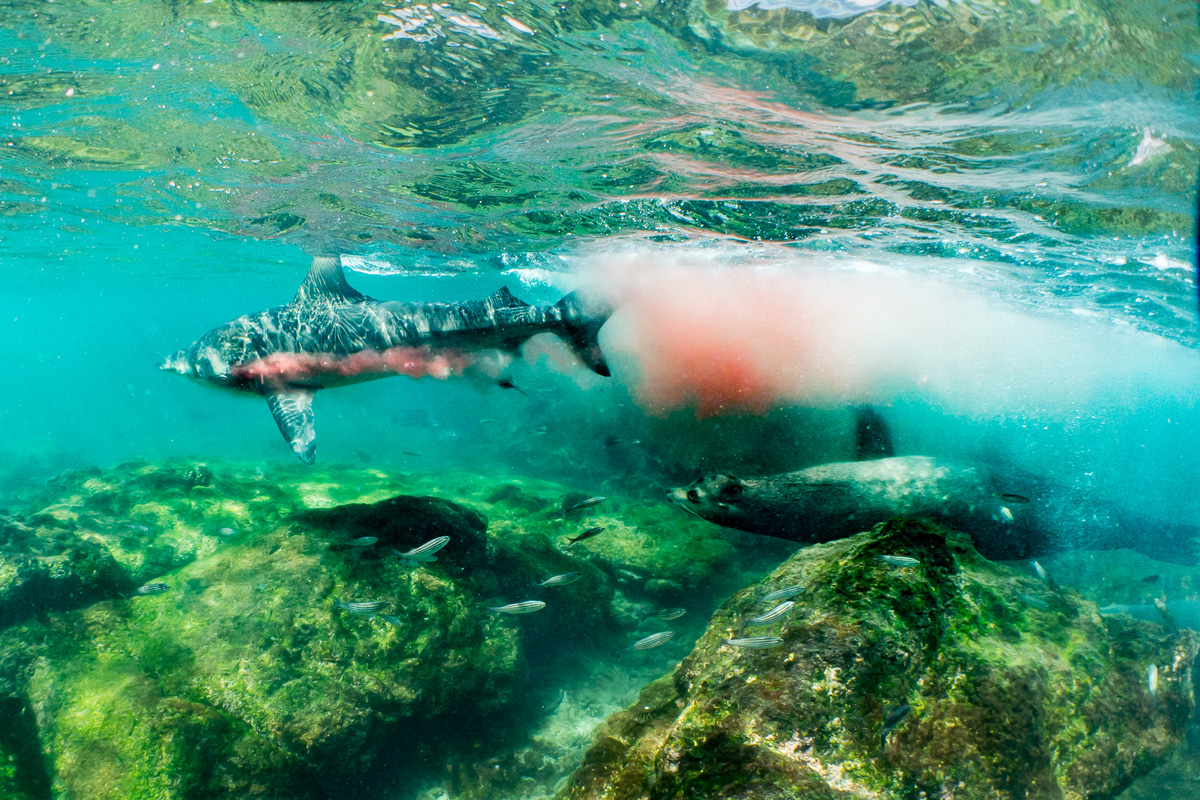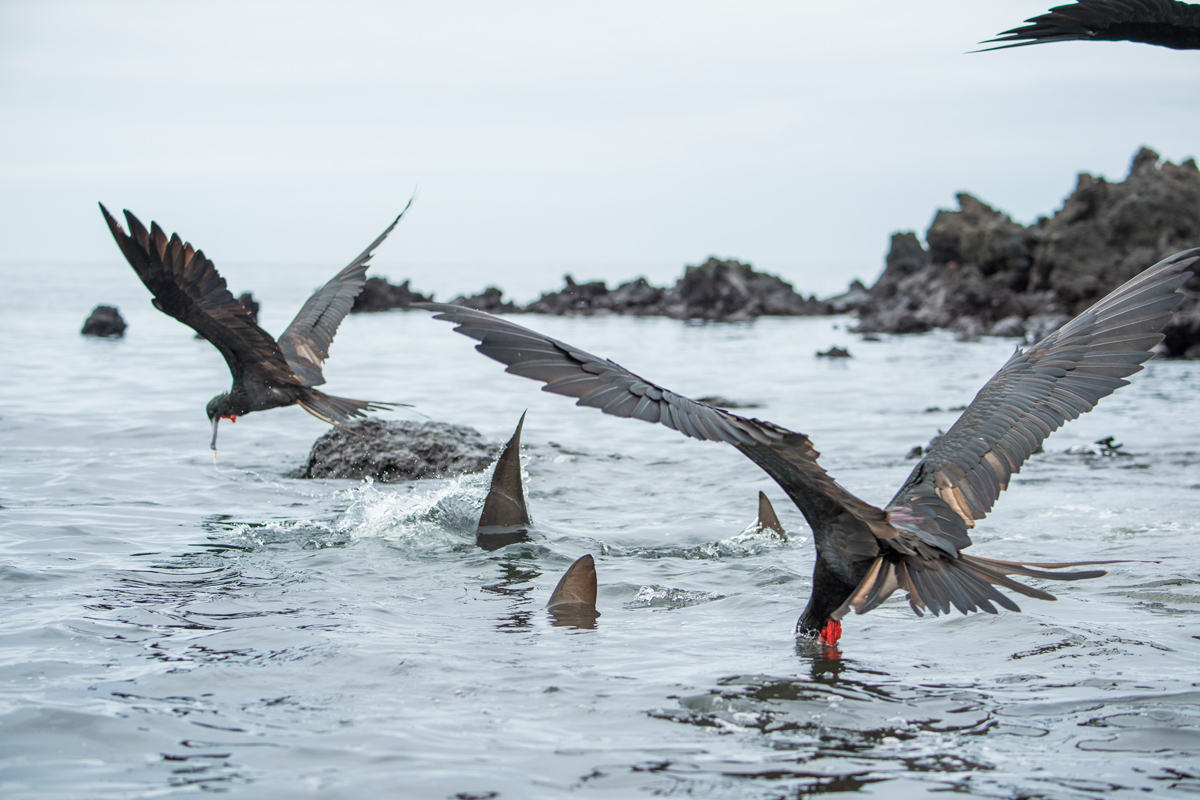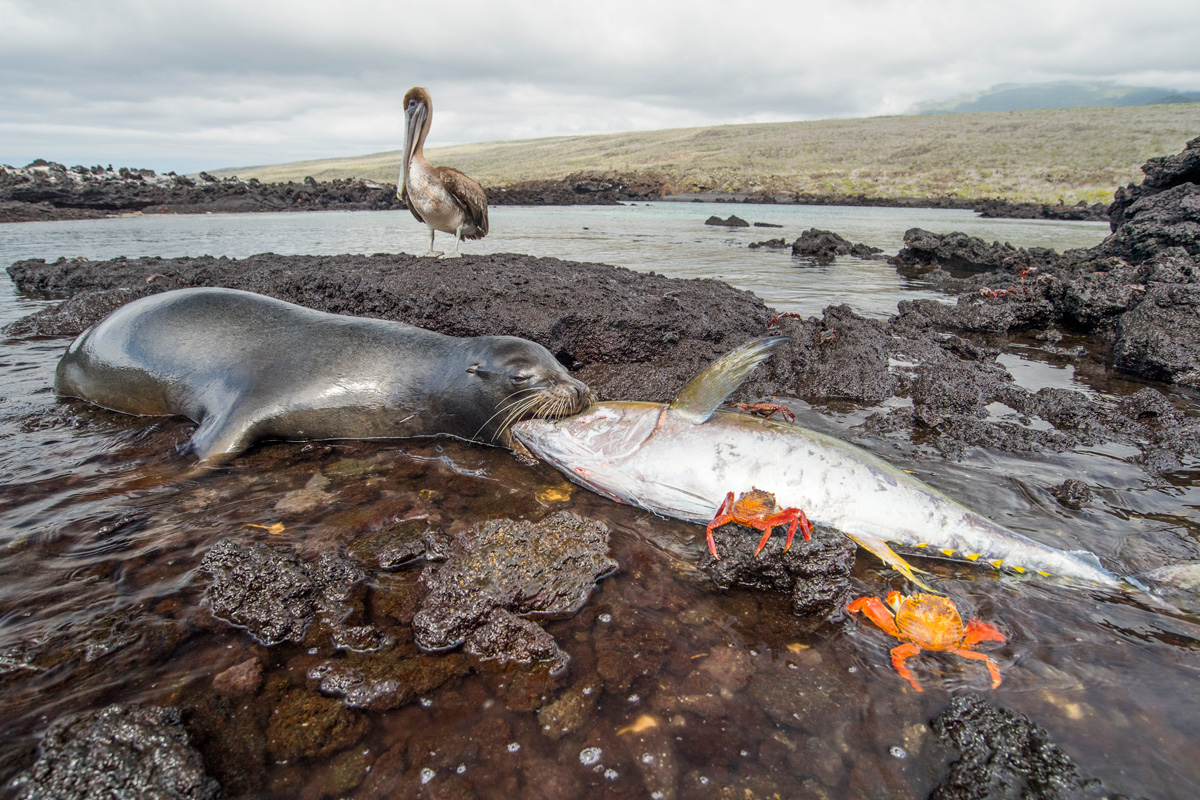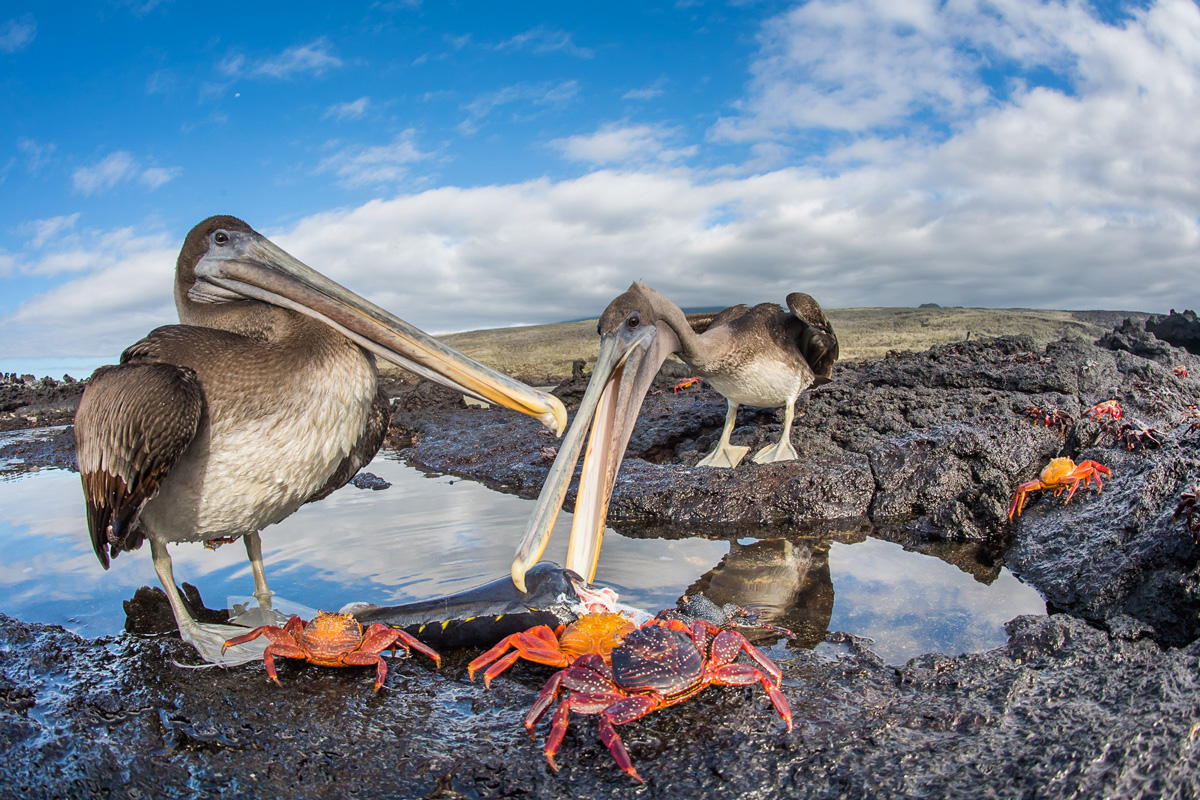In the Face of Climate Change, These Sea Lions Are Getting Smart
Posted on Categories Discover Magazine
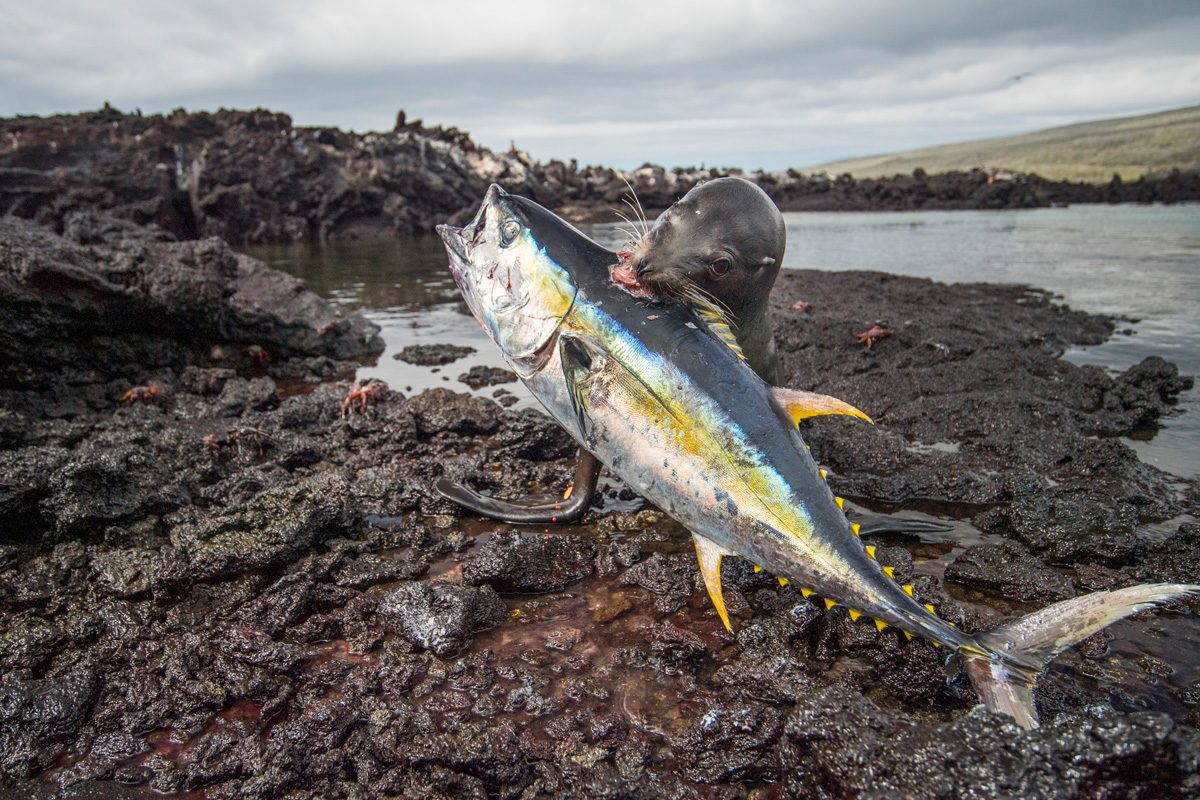
Using a small lava cove as trap, a small number of bulls have learned to round up pelagic yellowfin tuna, driving them into shallow nooks, where the exhausted fish often leap ashore in a last ditch attempt to escape. The oldest bull eats his fill after dispatching the prey with bites to nape and throat, while younger bulls take the scraps. (Credit: Tui de Roy)
The water churns in a chaotic flurry of fins and flippers. Hungry onlookers hover, swoop, and scurry, hoping to get in on at least the final stages of the action. There are deep growls, sprays of blood, and flashes of iridescent blue and yellow scales against black volcanic rock. It’s a scene so wild and unprecedented that when local fishermen first started reporting it a few years ago, their accounts might have been dismissed as unbelievable. But this is the Galápagos, a place where remarkable wildlife sightings are so commonplace that practically anything seems possible. Here, in two different fishhook-shaped coves on the islands of Isabela and Fernandina, Galápagos sea lions (Zalophus wollebaeki) were rumored to be successfully hunting yellowfin tuna (Thunnes albacares)—fish that can easily swim twice as fast as the sea lions, even when the marine mammals are lunging at top speed. When acclaimed wildlife photographer and naturalist Tui De Roy heard from a game warden that the rumors appeared to be true, she immediately started planning her next visit to the islands.
Having grown up in the Galápagos, where she’d spent countless hours watching the islands’ sea lions play beach ball with puffer fish, sink dinghies for fun, and taunt Sally Lightfoot crabs with their whiskers, De Roy knew better than most how intelligent and social these animals are. But even she was floored when she first saw a group of sea lions herd a handful of 50-pound tuna out of the water and onto the forbidding shore. “Even though I’d been told what they were doing,” says De Roy, “when I actually saw it I thought, ‘I can’t believe this is happening. I just can’t believe it.’”
While the sea lions’ ability to execute such a feat may have surprised De Roy, their drive to do so certainly didn’t. Over the past 30 years, the population of Galápagos sea lions has declined precipitously, from at least 40,000 individuals to fewer than 15,000. The charismatic mammals have faced a number of threats in recent decades, but by all accounts the most significant has been food scarcity. Pacific sardines (Sardinops sagax), small-bodied baitfish that need relatively cool water in order to spawn, were once the preferred meal for Galápagos sea lions because of their abundance and high fat content. But as the waters around the volcanic islands have warmed, and the frequency and severity of El Niño events have increased, sardines have become harder and harder to find. Without this rich food source, the sea lions are struggling to survive—especially during El Niño years, when up to 100 percent of the pups, 50 percent of the yearlings, and a substantial number of adults may die. It’s little wonder that some Galápagos sea lions have gotten creative in their quest for food.
Tuna, which are among the fastest fish in the sea, are much harder to catch than sardines. But because of both their heft and their similarly high-fat flesh, they are also a much more valuable prize. “I’ve seen big bull sea lions eat two thirds of a 50-pound tuna in one sitting,” says De Roy. And when the herding goes well, they might repeat that meal three or four times a day. (Perhaps that’s why the older bulls that frequent these two coves are among the biggest De Roy has seen in the Galápagos in recent years.) However, success is far from guaranteed. For these sea lions, pulling off such a high-stakes hunt requires three things: patience, teamwork, and exactly the right volcanic formations.
The jagged, black shores that ring the Galápagos Islands are nearly as iconic as the marine iguanas, penguins, and other archipelago ambassadors that reside there. Formed by lava that has repeatedly flowed into the sea and hardened into gnarled fingers, the coastline can be practically maze-like—a feature the tuna herders have learned to use to their advantage.
To start a hunt, a group of three to six sea lions gather outside the entrance of a narrow cove and patrol the water slowly, waiting for a school of tuna to pass by.
At the first sight of tuna, the sea lions begin zigzagging and porpoising on the seaward side of the school, gradually driving the fish toward the other end of the cove.
Patience and restraint are key. Chasing the tuna in the open ocean would be futile, so they bide their time, creating enough commotion that the nervous tuna unwittingly swim into the trap. As soon as the tuna enter the cove, one sea lion turns back to guard the outlet, cutting off the exit route for any fish that might try to reverse course.
The others continue pushing the tuna toward the shallows, driving the fish into a frenzy. The fever-pitched activity attracts a veritable menagerie of other hungry species, including blacktip sharks (Carcharhinus limbatus). But the sea lions are undeterred.
Finally, the hunters herd the tuna around the curve near the end of the cove. Sensing the opportunity to swim back toward open water, the tuna shoot forward in a desperate final bid for freedom.
But the fish have hit a dead end, and many surge straight onto the rocks.
Those that turn back frequently find themselves swimming straight into the jaws of a waiting sea lion. For the sea lions, catching a tuna is just the first half of the battle.
In addition to competing with each other, they have to contend with the sharks And in the aftermath of a hunt, it’s not unusual for a big blacktip to steal an entire tuna from a sea lion’s jaws.
“The intensity is quite something,” says De Roy, who was standing waist-deep in the water at the end of one of these hunts. “There are big, roiling masses of sharks in the water, and they’re in feeding frenzy mode.”
But most of the time, if the hunt is successful, there is plenty of tuna to go around.
The biggest bulls lay claim to the choicest cuts of meat, leaving the heads and tails to be snatched up by younger sea lions and a suite of scavengers, like this Brown pelican (Pelecanus occidentalis). An entire community of species benefits from the hunts, many of which have also felt the pressure of a changing climate.
Because tuna herding requires such specific shoreline formations, it probably can’t ever be a full replacement for the sea lions’ other declining food sources. But it demonstrates an adaptability that gives scientists hope for the future of the species.
